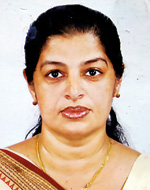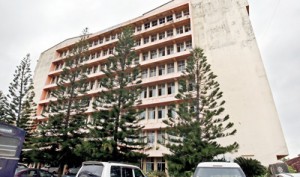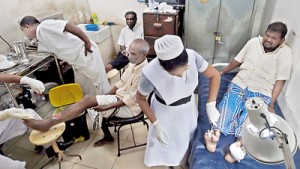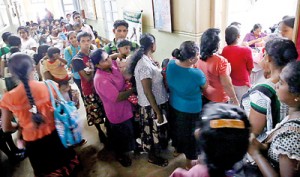News
All’s not well at Negombo Hospital
Urgent calls are being made for the crisis-hit Negombo Hospital, now under provincial administration, to be taken over immediately by Sri Lanka’s main Health Ministry after an alert on the safety of its main building saw patients being evacuated quickly.

Medical Superintendent Dr. Champa Aluthweera
In a related move, trade unions were also considering more drastic steps at the hospital from tomorrow if the authorities do not respond swiftly to the crisis, with emergency measures.
Staff members, particularly consultants, are urging the country’s main Health Ministry to take over this beleaguered 785-bed district general hospital which comes under the Western Province Health Ministry after the Sunday Times observed first-hand the crisis on Friday, during a visit there.
Many consultants who thronged the office of the Medical Superintendent (MS), Dr. Champa Aluthweera, were adamant that there was no support forthcoming from the provincial authorities or politicians.
Hard-hit by the need to abandon its main building, the Negombo Hospital is unable to deal with critically-ill patients who are rushed here.
Explaining that it now functions without an Intensive Care Unit (ICU) or a male medical ward, the MS says that critically-ill patients are stabilised in the Preliminary Care Unit (PCU) and then transferred to the Ragama Teaching Hospital or the National Hospital, Colombo.
The PCU itself is a poor shadow of what it had been earlier. The emergency evacuation of the main seven-storey building last weekend followed warning bells being sounded by the Atomic Energy Authority and the Civil Engineering Department of the University of Moratuwa which conducted an initial assessment of the building. The adjacent buildings in the hospital complex are unaffected.

The disastrous state of the seven-storey main building of the Negombo Hospital, now evacuated of patients. Pix by M.A. Pushpa Kumara
Coupled with the unsafe building issue are calls for urgent measures to tackle casualties, such as accident victims with severe head injuries on the brink of death, brought to the hospital as well as overcrowding and lack of space to meet the demands of an institution which has one of the largest outpatients departments (OPDs) in the country and a large number of admissions.
When casualties come in, the only thing that the staff can do currently is perform resuscitation and send them to other hospitals, it is understood. The PCU has been crammed into a small space with pill-bottles on a table pushed against the wall.
“We are facing a very difficult situation and every category in the hospital has been disturbed,” said MS Dr. Aluthweera.
Tension is mounting high, as some patients and their relatives are also threatening the staff, which could easily lead to a volatile situation, it is learnt.
Not a single provincial politician has deemed it necessary to visit the hospital and help the staff to deal with a crisis situation of immense proportions, consultants allege, quick to point out that they would however be most willing to be present at other functions, to go in procession and light the oil lamp.
With the evacuation of the building housing the surgical, medical, ear-nose-throat and eye wards as well as the preliminary care unit (PCU), clinics, OPD, operating theatres and ICUs, the adjacent buildings are chock-a-block with patients, the Sunday Times found.

The congested wound-dressing room
The OPD sees nearly 2,000 people seeking treatment daily, with the ‘catchment’ area of the Negombo Hospital, located strategically on the border of the Western and North Western Provinces being quite large. Closer to the hospital are also the Katunayake International Airport and the Free Trade Zone with a large number of factories.
“We simply cannot manage like this forever,” says Dr. Aluthweera, stressing that they need an immediate short-term plan to deal with this crisis-situation as well as a long-term plan. Some wards have been scattered around the buildings adjacent to the main one, while other wards have been amalgamated.
The 140-bed medical ward which also had numerous floor patients has now been reduced to 14 beds for females, the Sunday Times learns, while around 130 expectant mothers spend their time in corridors awaiting check-ups at the obstetric clinic.
In the gynaecological ward there are 20 patients for 11 beds, with more patients seated in the corridor. Fans in these wards only work in some areas and not others.
Babies are screaming and anxious mothers stand in queues with other patients, while the OPD is in a congested lobby, overflowing into corridors, while there is no place for the laboratory to function. The wound-dressing room is crowded with both surgical and infectious wounds being dressed in the same limited space leaving room for cross-infections.
The strident call by the consultants is that a Director from the Health Ministry should be stationed at the hospital itself to help the administrators on the spot. “Then that official can immediately approve funds on a case-by-case basis without the red tape of allocations being sent to the provincial ministry from the line ministry and the resultant delays of accessing them,” an irate consultant pointed out.

A corridor overflowing with patients
Another consultant was of the view that even the Health Ministry, after an initial flurry of meetings last weekend, seems to have washed its hands off the situation. This is while the Negombo Hospital staff has to face multiple issues, in accommodating a large number of patients in hardly available space, working under pressure in crowded areas without much facilities and also facing threats and intimidation by patients and their relatives.
The MS, meanwhile, recalls how the hospital administrators had pleaded with the Western Provincial Health Ministry over a long period of time to give the green-light for the danger assessment of the main building, but there had been no positive response. The Atomic Energy Authority had given an estimated cost of Rs. 2.5 million to check out the flaws of the building sometime back.
A walk around the recently-evacuated building is an eye-opener. The roof of each and every floor is fungus-ridden with major water-leaks through the concrete slabs. On some floors, make-shift aluminium chutes from the centre of the ceiling have been directed out through the windows to channel the water out. One needs only to look under a floor-tile to see water collected, while from the ceiling like icicles hang calcium carbonate.
Pointing out that there has been rapid deterioration in the building within the last one and a half years, Dr. Aluthweera who has been working day and night in the last week, without a break, says that “no one addressed this issue”.
The staff, meanwhile, is also working under trying conditions with nurses grumbling that they do not even have a place to change into their uniforms when they come on duty. Toilets for all, both staff and patients, seem to be a rare commodity.
Talking about the irony of the situation, the consultants point out that they were promised three ambulances to transfer casualties to other hospitals but this promise has not materialised. Ironically, to add insult to injury, the Gampaha health authorities have asked for an ambulance from Negombo Hospital as the Divulapitiya Hospital ambulance driver has gone on leave.
‘Abandoned’ is how the Negombo Hospital administrators and staff feel in the face of a ‘medical disaster’ of humongous proportions.
| Funds allocated for repairs but not disbursed Funds have been allocated ‘on paper’ early this month but not disbursed yet to repair and re-haul the sections in which the evacuated patients are being provided temporary accommodation as well as to re-fix essential equipment such as X-rays, the Sunday Times learns.Rs. 50 million has been earmarked for repairs and another Rs. 20 million to relocate essential equipment. As the Negombo Hospital struggles under a heavy load, nothing seems to be happening at ground level though with regard to these vital requirements. | |
| Provincial Health Ministry Sec. outlines steps taken, then goes mum When contacted Western Provincial Health Minister Ranjith Somawansa assured that they were “kepaweemen weda karana” (working with dedication measures) without going into detail and suggested that the Sunday Times speak to Provincial Health Ministry Secretary Pradeep Ratnayake.Mr. Ratnayake who pointed out that he was just the acting secretary said that three measures had been taken with regard to the Negombo Hospital crisis. According to him the issues with the building put up by the Korean company Keang Nam had been there from the time the construction was completed and the building was handed over. The first measure that the Provincial Health Ministry planned to do was build a new building, for which the plans were drawn, to accommodate the patients, he says, adding that the ministry began looking for funding for the construction, approaching the Treasury about a year ago. Although the Treasury promised the funding, no documents had been finalised and then with the change in the government nothing happened. Then the Provincial Ministry discussed with Japan which has promised to provide funding. Now a decision has to be made after the assessment by the AEA and the Moratuwa University whether the old building should be repaired or a new building should be constructed, said Mr. Ratnayake, who too became busy with meetings and did not pick up the phone although the explanations were not completed. Several calls to Dr. Deepthi Perera, Provincial Director of Health proved futile. Giving excuses that she was at meetings and would call back, not only did she not come back on this major public issue, neither did she answer her mobile, on Friday and yesterday. | |

